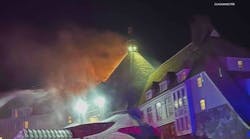Nov. 29--PETERSBURG -- Southside Virginia Emergency Crew has been providing rescue services to the city for more than 60 years and that relationship should continue, according to the rescue group.
Executive Director Edward "Bubby" Bish said Southside Virginia Emergency Crew is a good steward of the city's money. While the city annually provides $300,000 to the crew, that only represents 23 percent of its total budget of about $1.3 million. "Providing EMS would cost the city well over $300,000," Bish said.
Part of the reason Bish says that it would cost the city more than its annual contribution to the crew is the cost of equipment alone. Each ambulance costs $140,000 "without a stretcher, without any equipment." Some equipment such as cardiac monitors are approximately $30,000 each he said.
The crew gets money to pay for equipment through billing of insurance companies and Medicaid and Medicare and through grants from The Cameron Foundation and The John Randolph Foundation.
Bish recently presented a case before the Petersburg City Council last week on why the rescue crew was a needed and important part of the city's emergency services. The presentation was in response to an August meeting in which some city officials suggested that there was too much duplication of services between the Southside Virginia Emergency Crew the Petersburg Department of Fire, Rescue and Emergency Services.
Petersburg fire officials said that in 2011 Southside Virginia Emergency Crew responded to 6,664 calls for ambulance service. The Petersburg Department of Fire, Rescue and Emergency Services responded with the crew to about one third of those calls. The underlying question is whether the city fire department will try to better coordinate with the nonprofit ambulance service that was traditionally based on volunteers or whether the city should combine the two and take over all emergency services in Petersburg.
Bish said that better communication between the crew and the city's fire department is needed.
Another issue about Southside Virginia Emergency Crew has been response times. The crew has only one station in the city, which some city fire officials contend means response times are too long.
Bish also said that the response time for the crew is about 5.85 minutes for calls involving cardiac arrest, 6 to 8 minutes for serious emergencies. Some calls, such as when the crew is called to assist in lifting a patient, the response time may be longer, he said.
Response time was one of the reasons cited by the Petersburg Department of Fire, Rescue and Emergency Services in a presentation more than three months ago at the City Council Advance for eliminating funding to the crew and instead potentially combining the services.
Fire department officials argued that if instead of the city providing $300,000 to the crew each year, ambulances were stationed at each fire station, most areas of the city could be reached within five minutes.
But Bish said in his presentation that another contributing factor is the amount of travel the crew sometimes must do outside the city transporting patients to a hospital, something that increases a response time.
Bish also said Southside Virginia Emergency Crew has provided citizens excellent quality by implementing innovative rescue practices. He said the nature of services may change, and that within the next few years, he expects more calls to be of a preventative nature.
Bish talked about some of the innovative practices that the crew has implemented over the past several years, including a new "hypothermic protocol" used to increase cardiac arrest patient survival. He said that the crew implemented the practice in 2009.
As another indicator of the quality of care that the crew provides, Bish cited the rate of Return of Spontaneous Circulation in patients with cardiac arrest. He said that the national average is about 3 to 10 percent of all patients have a pulse return. For the Southside Virginia Emergency Crew, the rate is 25 percent.
The relationship between Southside Virginia Emergency Crew and the city has been discussed for years. In 1992, an informal study was undertaken by interns from Virginia State University. Four years later the "Blue Ribbon Study" was done, which was made up of community leaders, SVEC representatives, business owners and fire personnel. The 1996 study led to the city initially providing $80,000 a year in support of the crew's operations. The crew hired full-time staff as a result as well.
In 2008, as part of the city's efficiency review, the issue was examined again. That study said that the city should assume full responsibility of emergency medical services. The study noted that if EMS staffing was increased along with the number of ambulances in fire stations, it could reduce the engine company response times and the city would also maintain accountability.
- F.M. Wiggins may be reached at 804-732-3456, ext. 3254 or [email protected].
Copyright 2012 - The Progress-Index, Petersburg, Va.





